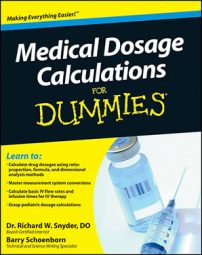Grasping some medical math basics — such as how to break down medical dosage problems into steps and use conversion factors — can simplify everyday situations all health care professionals face.
In addition to just knowing math, you’re going to need to know how to read and interpret doctors’ orders, and spot when there’s potential trouble.
Figuring IV flow rate, infusion time, and total volume
Whenever you’re administering intravenous (IV) infusions, you need to know the flow rate, infusion time, and total volume. Fortunately, calculating any one of these three variables is easy to do when you know the other two variables. Use the following equations:
-
flow rate (mL/hr) = total volume (mL) ÷ infusion time (hr)
-
infusion time (hr) = total volume (mL) ÷ flow rate (mL/hr)
-
total volume (mL) = flow rate (mL/hr) × infusion time (hr)
For example, if you must administer 1 L (1,000 mL) of fluid over 4 hours, use the first formula to calculate the flow rate, like so:
flow rate (mL/hr) = total volume (mL) ÷ infusion time (hr)
flow rate (mL/hr) = 1,000 ÷ 4
flow rate (mL/hr) = 250
The flow rate is 250 mL/hr.
Common conversion factors in medical dosage calculations
As a healthcare professional, you have to convert patient weights, fluid volumes, medication weights, and more. Conversion math isn’t hard to do as long as you know the basic conversion factors. Here are the most useful ones:
-
Converting lb to kg and kg to lb
lb = kg × 2.2
kg = lb ÷ 2.2
-
Converting mL to L and L to mL
mL = L × 1,000
L = mL ÷ 1,000
-
Converting mg to g, g to mg, mg to mcg, and mcg to mg
mg = g × 1,000
g = mg ÷ 1,000
mcg = mg × 1,000
mg = mcg ÷ 1,000
Unacceptable abbreviations in prescriptions
Making sure that you correctly calculate a dose doesn’t matter much if the medication itself is incorrect or the dosing instructions are unclear. Some abbreviations in prescriptions are unacceptable because they cause ambiguity and confusion (the enemies of patient safety and quality healthcare!). For this reason, you don’t want to see these abbreviations on any medical orders you work with.
| Abbreviation | Mistaken Meanings | Better Choice |
|---|---|---|
| DC or D/C | Does it mean “discontinue” or “discharge”? |
Write discontinue or discharge. |
| HS | Does it mean “half-strength” or “at bedtime”? |
Write at bedtime or a designated time. Also write out the specific dosing strength and/or quantity |
| QD | Does it mean “every day” or “right eye”? QD looks like OD, which means “right eye.” (OS means “left eye.”) |
Write every day. |
| QOD | Does it mean “every other day” or “daily”? |
Write every other day or daily, according to patient’s needs. |
| MSO4 | Does it mean “magnesium sulfate” or “morphine sulfate”? |
Write magnesium sulfate or morphine sulfate. |
| U or IU | Does it mean “unit” or “zero”? Could it be mistaken for “0” or “10”? |
Write units. |
| IV | Does it mean “intravenous,” “international units,” or “4”? |
IV is an acceptable abbreviation for “intravenous,” but the doc could write international units or intravenous to be clearer. Or “4” |
| SQ or SC | Does it mean “subcutaneous” or could it be mistaken for “5Q” (“5 every”)? |
Write Subq, subcut, subcutaneous, or 5 every. |
| TIW | Does it mean “twice a week” or “three times a week” (the real meaning)? |
Write twice a week or three times a week. |
| cc | Does it mean “cubic centimeter” or “milliliter”? Could it be mistaken for “00”? |
Write milliliter or mL. |
| Ug or g | Does it mean “microgram” or “Ugh”? Could it be mistaken for mg? |
Write microgram or mcg. |
| OD | Does it mean “once daily” or “right eye”? |
Write once daily or right eye. |
Source: The National Coordinating Council for Medication Error Reporting and Prevention (NCC MERP). http://www.nccmerp.org/

